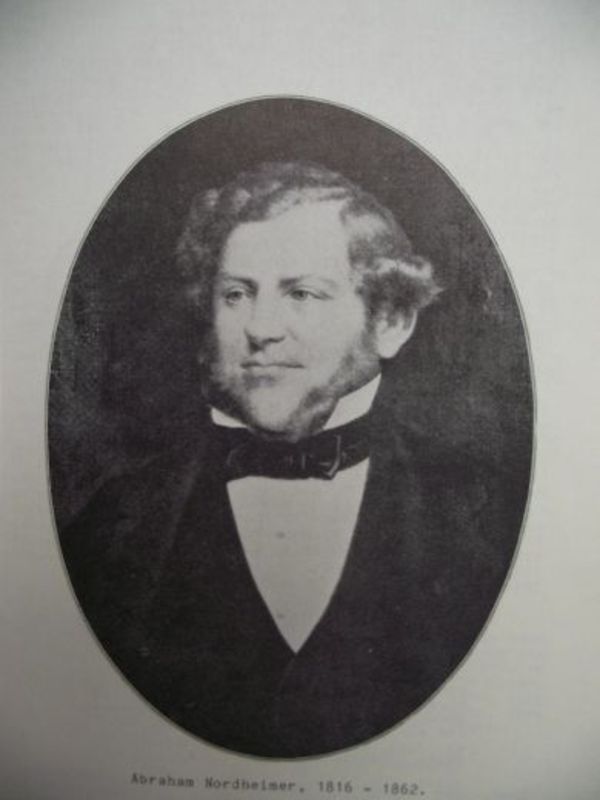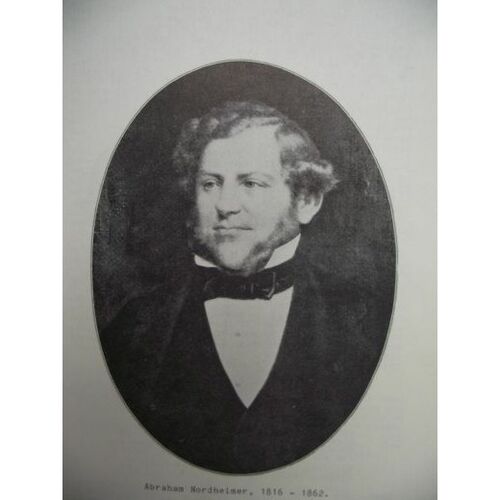
Source: Link
NORDHEIMER, ABRAHAM, musician, music dealer, and publisher; b. 24 Feb. 1816 at Memmelsdorf, near Bamberg (Federal Republic of Germany), sixth son of Meier Nordheimer, a cattle dealer, and Esther Nathan; m. Fanny Rosenthal, and they had at least three sons and two daughters; d. 18 Jan. 1862 in Bamberg.
Abraham Nordheimer’s family had held property at Memmelsdorf in Bavaria for over a century, but, perhaps because of restrictive laws against Jews, a number of sons immigrated to the United States in the 1830s. Abraham and his brother Samuel apparently went to New York in 1839 where an older brother Isaac, an Oriental scholar and author of a Hebrew grammar, had settled a few years earlier. It has been related that a Canadian officer met Abraham in New York and induced him to become music teacher to the family of Sir Charles Bagot*. All that can be ascertained is that Abraham began advertising in the Kingston Chronicle and Gazette on 13 July 1842, six months after Bagot’s arrival in Kingston, identifying himself clearly as a newcomer and a professor of music from Germany. He “begs to intimate to the inhabitants of this City, that he intends giving lessons on the Piano Forte, Violin and in Singing. Piano Fortes tuned.” In November Nordheimer announced that he had opened a store which sold imported printed music and instruments. He is said to have formed and directed a musical society in Kingston; the Chronicle and Gazette in March 1844 notes that members of the Kingston Harmonic Society could obtain admission cards to its private concert at his store.
In June 1844 Abraham and Samuel Nordheimer opened a music store in Toronto where they promised to have always “on hand a large and well selected stock of English, French, Italian and German Songs . . . the newest and most popular Operas, Waltzes, Quadrilles . . . an assortment of the celebrated piano fortes,” as well as a “select Stock of patterns for Needlework, and Berlin wool to match.” The earliest Nordheimer publications were reprints of European music, but almost from the beginning they published Canadian compositions as well. The first plate number was assigned to Joseph Philip Knight’s “Beautiful Venice”; a later item featured Canadian composer St George B. Crozier and dates from 1846. By about 1852 100 pieces had been published. Many of the original Canadian pieces were by Toronto musicians, including George William Strathy, Martin Lazare, Jules Hecht, and J. P. Clarke*. The longest work published in Abraham’s lifetime was Clarke’s Lays of the maple leaf, or songs of Canada (1853). The firm undoubtedly produced the largest number of Canadian sheet music publications before confederation and was probably the first to specialize entirely in music. The engraving and the paper of their publications are of a high quality.
The Nordheimer company filled a definite need in a rapidly expanding society. Although the firm did not build its own pianos until late in the century, as early as 1845 it had become the agent for such manufacturers as Stodart and others in New York and Boston. About 1848 a piano and music store was opened in Montreal and before Abraham’s death branches were established in Hamilton and London. The Nordheimers also invited famous performers to visit Canada and established Nordheimer’s Hall in Montreal.
The roles played by Abraham and Samuel are difficult to distinguish. As the elder brother and the only one whose name is associated with the Kingston years, Abraham must have been the guiding spirit. Abraham is also the only one whose name is recorded as a performer. As well as being a pianist and vocalist, in the 1840s he played the second violin in the Toronto Philharmonic Society, was its instrumental manager, and belonged to its committee. Abraham was an early member of the Toronto Hebrew Congregation (Holy Blossom) and, with Judah G. Joseph*, bought land in 1849 for the Jewish cemetery in Toronto. He was also an original director of the Canada Permanent Building and Savings Society established in 1855. He died on a visit to Germany, survived by his wife and a number of children. Abraham Nordheimer established a trade name that is still perpetuated as a brand name of Heintzman pianos and is the oldest such name in Canadian music.
Central Archives for the History of the Jewish People (Jerusalem), register of births, marriages, and deaths of Memmelsdorf, Bavaria, 1811–75. Chronicle & Gazette (Kingston), 13 July 1842, 2 March 1844. Globe, 10 Feb. 1862. Toronto Patriot, 7 June 1844. Cyclopaedia of Canadian biog. (Rose, 1886), 663–65. 1840–1903 . . . the house of Nordheimer . . . ([Toronto, 1903]). The Jew in Canada; a complete record of Canadian Jewry from the days of the French régime to the present time, ed. A. D. Hart (Toronto and Montreal, 1926). B. G. Sack, History of the Jews in Canada from the earliest beginnings to the present day, trans. Ralph Novek (Montreal, 1945). D. J. Sale, “Toronto’s pre-confederation music societies, 1845–1867” (unpublished ma thesis, University of Toronto, 1968). F. E. Dixon, “Music in Toronto, as it was in the days that are gone by forever,” Mail and Empire (Toronto), 7 Nov. 1896.
Cite This Article
Helmut Kallmann, “NORDHEIMER, ABRAHAM,” in Dictionary of Canadian Biography, vol. 9, University of Toronto/Université Laval, 2003–, accessed April 25, 2025, https://www.biographi.ca/en/bio/nordheimer_abraham_9E.html.
The citation above shows the format for footnotes and endnotes according to the Chicago manual of style (16th edition). Information to be used in other citation formats:
| Permalink: | https://www.biographi.ca/en/bio/nordheimer_abraham_9E.html |
| Author of Article: | Helmut Kallmann |
| Title of Article: | NORDHEIMER, ABRAHAM |
| Publication Name: | Dictionary of Canadian Biography, vol. 9 |
| Publisher: | University of Toronto/Université Laval |
| Year of revision: | 1976 |
| Access Date: | April 25, 2025 |



